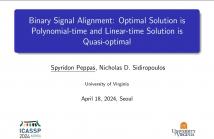
- Read more about Binary Signal Alignment: Optimal Solution is Polynomial-time and Linear-time Solution is Quasi-optimal
- Log in to post comments
In this paper we revisit a recently proposed underlay communication scheme which relies on repetition of the secondary signal at the transmitter and canonical correlation analysis CCA at the (multi-antenna) receiver. In this setting, CCA can provably extract the underlay signal in the presence of potentially strong and time-varying primary interference, without any channel knowledge.
- Categories:
 35 Views
35 Views
- Read more about Tag Antenna Structure Calibrated Backscattering Signal Detection
- Log in to post comments
Backscatter Communication (BackCom) is gaining popularity due to its potential for sustainable and low-cost Internet of Things (IoT) applications. However, due to the limited resources of passive tags, optimizing the backscatter modulation is critical for the widespread use of this technology. Current backscatter modulation designs ignore the impact of the tag’s antenna structure, which we show in this paper to have a negative effect on system performance and lead to design discrepancies.
- Categories:
 19 Views
19 Views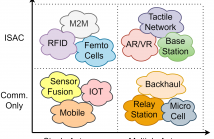
- Read more about In-Band Full-Duplex Solutions in the Paradigm of Integrated Sensing and Communication
- 1 comment
- Log in to post comments
The paper discusses different aspects in favor of using in-band full-duplex frontends for integrated sensing and communication (ISAC), considered for deployment of future 5G/6G infrastructure. Possible scenarios for practical utilization of the technology are discussed with additional focus on self-interference cancellation issue. An possible system implementation on abstract level is presented for cellular communication scenario.
- Categories:
 69 Views
69 Views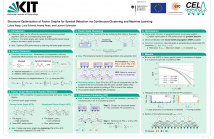
- Read more about Structural Optimization of Factor Graphs for Symbol Detection via Continuous Clustering and Machine Learning
- Log in to post comments
We propose a novel method to optimize the structure of factor graphs for graph-based inference. As an example inference task, we consider symbol detection on linear inter-symbol interference channels. The factor graph framework has the potential to yield low-complexity symbol detectors. However, the sum-product algorithm on cyclic factor graphs is suboptimal and its performance is highly sensitive to the underlying graph. Therefore, we optimize the structure of the underlying factor graphs in an end-to-end manner using machine learning.
poster.pdf
- Categories:
 36 Views
36 Views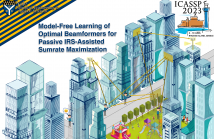
- Read more about Model-Free Learning of Optimal Beamformers for Passive IRS-Assisted Sumrate Maximization
- Log in to post comments
Although Intelligent Reflective Surfaces (IRSs) are a cost-effective technology promising high spectral efficiency in future wireless networks, obtaining optimal IRS beamformers is a challenging problem with several practical limitations. Assuming fully-passive, sensing- free IRS operation, we introduce a new data-driven Zeroth-order Stochastic Gradient Ascent (ZoSGA) algorithm for sumrate optimization in an IRS-aided downlink setting.
ZoSGA_Poster.pdf
- Categories:
 49 Views
49 Views
- Read more about SUPERVISED LEARNING BASED SPARSE CHANNEL ESTIMATION FOR RIS AIDED COMMUNICATIONS
- Log in to post comments
An reconfigurable intelligent surface (RIS) can be used to establish line-of-sight (LoS) communication when the direct path is compromised, which is a common occurrence in a millimeter wave (mmWave) network. In this paper, we focus on the uplink channel estimation of a such network. We formulate this as a sparse signal recovery problem, by discretizing the angle of arrivals (AoAs) at the base station (BS). On-grid and off-grid AoAs are considered separately. In the on-grid case, we propose an algorithm to estimate the direct and RIS channels.
- Categories:
 12 Views
12 Views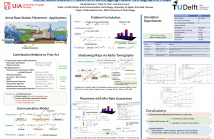
- Read more about Aerial Base Station Placement Leveraging Radio Tomographic Maps
- Log in to post comments
Mobile base stations on board unmanned aerial vehicles (UAVs)
promise to deliver connectivity to those areas where the
terrestrial infrastructure is overloaded, damaged, or absent. A
fundamental problem in this context involves determining a
minimal set of locations in 3D space where such aerial base
stations (ABSs) must be deployed to provide coverage to a set of
users. While nearly all existing approaches rely on average
characterizations of the propagation medium, this work
- Categories:
 32 Views
32 Views

- Read more about ADAPTIVE WIRELESS POWER ALLOCATION WITH GRAPH NEURAL NETWORKS
- Log in to post comments
- Categories:
 25 Views
25 Views
- Read more about Deep Actor-Critic for Continuous 3D Motion Control in Mobile Relay Beamforming Networks
- Log in to post comments
The paper studies the motion control for mobile relays imple-
menting cooperative beamforming to aid the communication
between a source-destination pair. We consider an urban com-
munication scenario, where the channels exhibit spatiotempo-
ral correlations and thus can be learned. The relays move in a
time-slotted fashion within a three-dimensional cube. During
every slot, the relays beamform optimally to maximize the
Signal-to-Interference+Noise Ratio (SINR) at the destination
- Categories:
 23 Views
23 Views